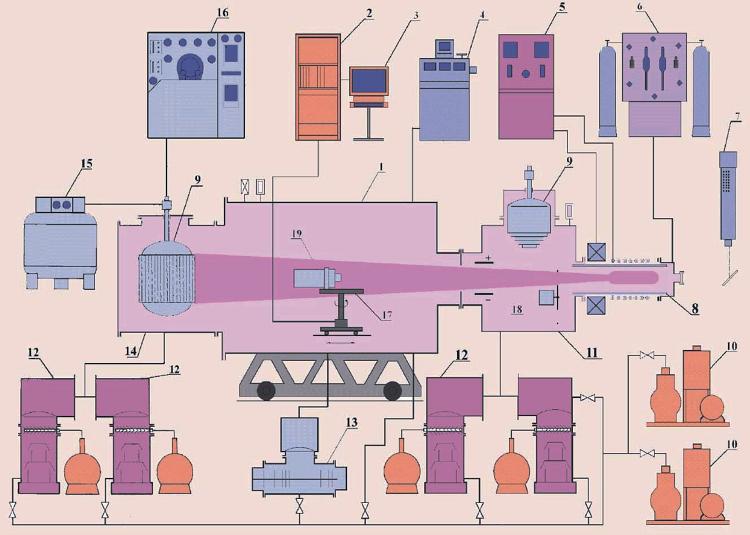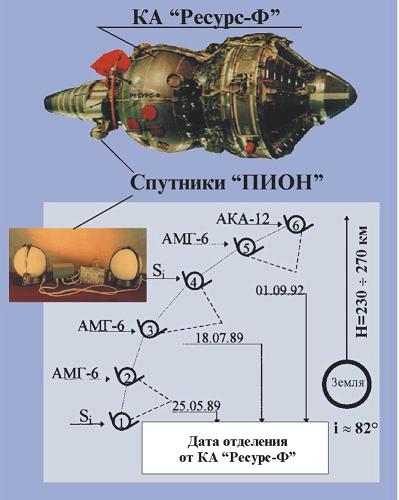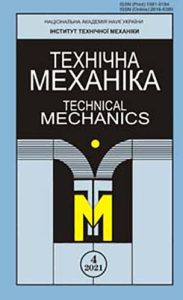Department of aerogas dynamics and technical systems dynamics
Head of department – Corresponding Member of the National Academy of Sciences of Ukraine, D.Sc., Professor V. I. Tymoshenko
In 1988, with direct financial support from Energia Research and Production Association and Yuzhnoye Design Office, a vacuum aerodynamic cryogenic-pumping plant (VAU-2M) was put into operation at the department. In performance, the plant compares well with the best foreign closed-circuit plants operating on a refrigeration cycle.

Basic parameters of the plant
| № п/п | Prameter | Measure | Quantity value |
| 1 | Working chamber volume | m3 | 3.0 |
| 2 | Source chamber volume | m3 | 0.5 |
| 3 | Working chamber pressure | Torr | 5•10-6…5•10-5 |
| 4 | Source chamber pressure | Torr | 5•10-5…5•10-4 |
| 5 | Working chamber pumping speed | l•с-1 | 8•10-3 |
| 6 | Source chamber pumping speed | l•с-1 | 6•10-3 |
| 7 | Mass-average flow velocity | m•с-1 | 4•10-3…8•10-3 |
| 8 | Flow ionization degree | deg | 10-2 … 10-6 |
| 9 | Flow divergence angle | deg. | <=3 |
| 10 | Working chamber core diameter | mm | 0.1 |
Plant layout

Using the plant, a number of new results have been obtained on:
- measurement of effective scattering cross-sections of atoms and molecules of rarefied gas for collisions in the medium interaction energy range (about 10 eV);
- static and dynamic tests of untight spacecraft compartments and scientific and service satellite-borne equipment;
- determination of the momentum exchange coefficients and scattering indicatrices of supersonic neutral flows scattered by the basic structural materials of spacecraft coatings (AMG-6 alloy, screen-vacuum heat insulation, solar battery fragment, AK-12 enamel).
These results made it possible to conduct full-scale aerodynamic experiments using PION passive reference satellites.

A space experiment called «Variation» was conducted together with Central Special Design Office, Nauka Scientific and Technical Center (Samara, Russia), and Kosmos Research Institute and Computing Center (Moscow). Two spherical satellites of much the same size (diameter about 0.3 m) and mass (about 45 to 50 kg), but coated with different structural materials [AMG-6 alloy, glass fabric (Si), and nitroenamel (AKA-12)] were injected into the same orbit at a time. The use of existing space control equipment for obtaining information on the orbital period variation ΔT of the satellites made it possible to eliminate the atmospheric density from the information being processed and determine the ratio Cxi/Cxj of their drag coefficients.
The results of the full-scale and laboratory experiments are given in the table.
| Data source | CX1 / CX2 | CX3 / CX4 | CX6 / CX5 |
| Laboratory simulation | 1.045 | 0.957 | 1.042 |
| Full-scale experiment | 1.039 | 0.984 | 1.035 |
The calibration values of the drag coefficients of models of the PION satellites had been measured in the VAU-2M vacuum aerodynamic plant before their launch. A qualitative and quantitative agreement between the results of the laboratory and full-scale experiments made it possible to conclude that the simulation of the physical features of interaction of high-velocity rarefied gas flows with the basic structural materials of satellite coatings in the VAU-2M plant followed by transferring them to actual flight conditions is sufficiently adequate.
| PHONE NUMBER: | +38-056-372-06-41 |
| E-MAIL: | vitymoshenko@nas.gov.ua |

